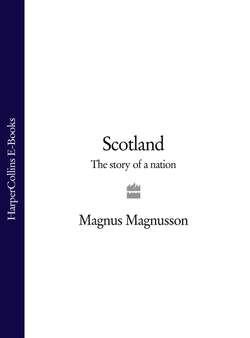Читать книгу Scotland: The Story of a Nation - Magnus Magnusson - Страница 13
Maes Howe on Orkney (3000 BC)
ОглавлениеIn 1861 an assiduous local antiquary named J. Farrer, along with a friend, George Petrie, dug their way into the heart of a great green mound known as Maes Howe. They had no idea what to expect. First they tried to make their way along the entrance passage. When they found it blocked solid, they broke through a hole in the top of the mound. They dropped into a central chamber choked with clay and stones, and had it cleared by their workmen. What they found disappointed them: it was clearly a burial chamber, with three built-in recesses or cells for bodies, but all they found was a fragment of a human skull and some horse bones and teeth.
They also discovered, however, that they were not the first ‘moderns’ to have broken into Maes Howe. In the middle of the twelfth century AD, a band of Norse crusaders (‘Jerusalem-farers’) had dug a hole in the roof of what they called ‘Orkahaug’ and dropped in, and the signs of their incursion were still apparent when Farrer and Petrie made their entry. The Norsemen had had their reasons for breaking into the chamber: they knew that the kings of antiquity had been buried in huge burial mounds accompanied by their choicest treasures and weapons, and ransacking burial mounds was a favoured diversion for viking heroes. But the crusaders had found nothing to satisfy their greed in Maes Howe, and had scrawled their disappointment – and their excuses for failure – in runic graffiti on the walls:
To the north-west a great treasure is hidden. It was long ago that a great treasure was hidden here. Happy is he who finds the great treasure.
It is surely true what I say, that treasure was taken away. Treasure was carried off in three nights before these Jerusalem-farers broke into this howe.
I make no excuses for returning to Orkney on this lightning tour of prehistoric Scotland, for Orkney is an archaeological paradise, with more outstanding monuments and sites than any other part of Britain of similar size. Maes Howe itself, which is acclaimed as the finest chambered tomb in north-west Europe, is associated with the Orkney farmers who built the Standing Stones of Stenness and the Ring of Brogar, and whose ancestors may have lived at Skara Brae. It was built within a century or two of 3000 BC. The mound stands more than seven metres high, and measures thirty-five metres across. The lofty central chamber is relatively small (some 4.6 metres square) and is approached by a low, stone-flagged entry-passage. The passage points south-west, and in the evenings around the shortest day of the year (21 December) the rays of the setting sun shine directly into the burial chamber.
Maes Howe is a miracle of early engineering. It is built almost entirely of huge flagstone slabs (megaliths), the largest of which weigh more than thirty tonnes. The walls of the central chamber converge in overlapping slabs of stone to form a vaulted ceiling; the final square of space was closed with slabs.
But Maes Howe has even more to offer than this amazing feat of prehistoric architecture, and for that we have the Norsemen to thank. The graffiti carved by the Orkney crusaders are not the only inscriptions in this fascinating place. After the first Norse break-in, the old burial chamber seems to have become a popular venue for courtship. One boastful inscription states boldly, Thorný bedded: Helgi carved [it]. Another, more gallantly, says, Ingigerð is the sweetest woman there is. Another refers obliquely to the amorous activities of the local merry widow: Ingibjörg the fair widow: many a woman has lowered herself to come in here; a great show-off. Erlingr.
They form part of the largest collection of runic inscriptions anywhere in the viking world – and the fact that their subject-matter is so commonplace gives them, for me, a special value. These are not the epics of kings and heroes which you find in the Icelandic sagas, but the authentic voices of the ordinary folk who, throughout history, are usually as anonymous as a flock of birds. Maes Howe was the ancient, brooding, mysterious place which the Norsemen of Orkney made their own.
